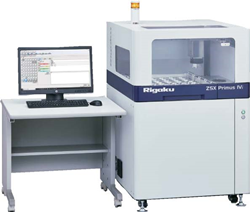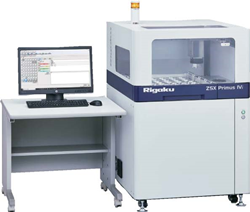
Rigaku ZSX Primus IVi WDXRF Spectrometer
The ZSX Primus IVi spectrometer offers a tube-below configuration optimized for the measurement of a variety of sample types including liquids, alloys, and plated metals.
TOKYO (PRWEB)
July 12, 2020
Rigaku Corporation is pleased to announce the introduction of the new Rigaku ZSX Primus IVi tube-below sequential wavelength dispersive X-ray fluorescence (WDXRF) spectrometer.
WDXRF analyzers are known for high sensitivity and spectral resolution, offering non-destructive trace elemental analysis for quality control, and are often employed by research institutions for a variety of applications. The ZSX Primus IVi spectrometer offers a tube-below configuration optimized for the measurement of a variety of sample types including liquids, alloys, and plated metals. Together with the standard optics tube-above configuration of the ZSX Primus IV system, the new ZSX Primus IVi spectrometer offers an unmatched portfolio of WDXRF capabilities.
The new spectrometer features a number of improvements from previous systems. The ZSX Primus IVi design offers the smallest footprint available in its class. The efficiency of the new drive sequence decreases time between multiple high-speed precision measurements. The redesigned control systems optimize a series of movement sequences, also resulting in shortened measurement times.
The ZSX Primus IVi system includes a patented vacuum partition system for analyzing liquids. Because the spectroscopic chamber is separated from the sample chamber when changing helium gas, the conversion from vacuum atmosphere to helium atmosphere can be completed in under two minutes. Helium consumption is further reduced compared to models where the spectroscopic chamber must also be fully purged.
The Rigaku optical system is resistant to impact by sample surface height, and enables suppression of X-ray intensity changes caused by variation in distance from the tube. Accuracy of analysis is enhanced by minimizing the effects from differences in fusion molds used in glass bead formulation and the impact of uneven sample surfaces.
Another key advantage is the enhanced ZSX Guidance software, standard for the equipment, which guides the user through automated optimized analysis settings. The software includes a quantitative application auto-configuration features that automatically sets measurement conditions and various corrections based on the user’s own standards. An error prevention function, which can set an access level for each operator, was also added for worry-free operation.
The software is programmable for routine, everyday analysis using removable sample trays. Sample ID settings for each tray facilitates easy copy-and-paste for efficient measurements. Improved accuracy of liquid sample analysis is achieved by enabling the correction of geometry effect caused by the geometry of liquid sample cups.
Key Features
-
Tube-below optics – Tube-below optics enable convenient functionality for typical gravity loaded samples such as liquids, and includes new sample film corrections. - ZSX Guidance software – Built-in XRF expertise handles sophisticated settings. Available application packages enable turnkey operations.
- High-speed analysis – Throughput has been improved by high-speed sample transportation, goniometer drive, data processing and effective driving control.
- Digital Multi-Channel Analyzer (D-MCA) – D-MCA X-ray counting system delivers improved precision with higher counting linearity and the ability to collect multiple PHA settings in the same measurement.
- Analytical functions utilizing scattered radiation (FP Scatter Correction) -The impact of unmeasured ultra-light elements is estimated using scattered radiation measurements to account for this portion of the sample composition, resulting in higher semi-quantitative accuracy.
- Point and mapping analysis – Equipped with a high-resolution camera that allows the user to zoom in on small features for proper identification and analysis. Enables accurate analysis by eliminating differences in sensitivity caused by measurement placement.
About Rigaku
Since its inception in Japan in 1951, Rigaku has been at the forefront of analytical and industrial instrumentation technology. Rigaku and its subsidiaries form a global group focused on general-purpose analytical instrumentation and the life sciences. With hundreds of major innovations to their credit, Rigaku companies are world leaders in X-ray spectrometry, diffraction, and optics, as well as small molecule and protein crystallography and semiconductor metrology. Today, Rigaku employs over 1,400 people in the manufacturing and support of its analytical equipment, which is used in more than 90 countries around the world supporting research, development, and quality assurance activities. Throughout the world, Rigaku continuously promotes partnerships, dialog, and innovation within the global scientific and industrial communities.
For further information, contact:
Thomas F. McNulty
Vice President, Materials Analysis SBU
Rigaku Americas Corporation
Tel: 281-362-2300 x207
eMail: tom.mcnulty@rigaku.com
Rigaku Corporation
Tokyo, Japan
Tel: +81 3-3479-0618
eMail: info-gsm@rigaku.co.jp
Rigaku Europe SE
Tel: +49 6102 77999 51
eMail: rese@rigaku.com
Share article on social media or email:

